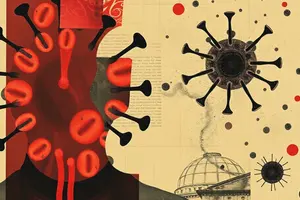Podcast
Questions and Answers
What is inflammation?
What is inflammation?
An important nonspecific defense reaction to tissue injury.
Which of the following are cardinal signs of inflammation?
Which of the following are cardinal signs of inflammation?
- Redness
- Heat
- Swelling
- Loss of function
- All of the above (correct)
The chemicals released by damaged cells include histamine, kinins, prostaglandins, and __________.
The chemicals released by damaged cells include histamine, kinins, prostaglandins, and __________.
leukotrienes
The acute inflammatory response begins when healthy tissue cells release chemical signals.
The acute inflammatory response begins when healthy tissue cells release chemical signals.
What is the role of neutrophils in the inflammatory response?
What is the role of neutrophils in the inflammatory response?
What does bradykinin do in the inflammatory response?
What does bradykinin do in the inflammatory response?
What is the effect of prostaglandins in the context of inflammation?
What is the effect of prostaglandins in the context of inflammation?
The increase in blood flow during inflammation helps to introduce more antimicrobial factors and leukocytes.
The increase in blood flow during inflammation helps to introduce more antimicrobial factors and leukocytes.
Flashcards are hidden until you start studying
Study Notes
Inflammation
- Inflammation is a nonspecific defense reaction, triggered by tissue injury.
- The immediate response to injury or cell death is acute inflammation.
- Cardinal signs of inflammation:
- Redness (rubor)
- Warmth (calor)
- Pain (dolor)
- Swelling (tumor)
- Loss of function (functio laesa)
Chemicals Released by Damaged Cells
- Histamine: Causes vasodilation and increased permeability of blood vessels.
- Kinins: Cause vasodilation and increased permeability of blood vessels.
- Prostaglandins: Intensify histamine and kinin effects.
- Leukotrienes: Increase blood vessel permeability and promote phagocytic attachment.
Beginning of Inflammatory Response
- Injured tissue cells release inflammatory mediators.
- Selectins on activated endothelial cells attract and attach neutrophils.
- Neutrophils roll along the endothelium and encounter inflammatory mediators, activating integrins.
- Integrins bind to endothelial adhesion molecules like ICAM-1 and VCAM-1, causing neutrophils to stick and stop rolling.
- Neutrophils undergo shape changes and squeeze through the endothelial wall (extravasation) into the interstitial tissue fluid.
- Chemotactic factors (substances released by bacteria, mast cells, and tissue breakdown products) attract neutrophils and other leukocytes to the infection site.
Inflammatory Mediators
- Inflammatory mediators raise acidity in the surrounding fluid, activating kallikrein.
- Kallikrein splits bradykinin from its precursor chain.
- Bradykinin binds to receptors on the capillary wall, increasing permeability and allowing fluid and leukocytes to enter the infected tissue.
- Bradykinin also binds to mast cells, causing degranulation and release of histamine.
- Damaged nerves release substance P which further promotes mast cell mediator release.
Histamine
- Histamine widens intercellular junctions in the capillary wall, increasing fluid, leukocyte, kallikrein, and bradykinin precursor movement, leading to edema.
- Bradykinin stimulates the production of prostaglandins (PGE2 and PGF2) contributing to tissue swelling.
- Prostaglandins bind to nerve endings, causing pain.
Changes in Cells
- Mast cell activation allows phospholipase A2 to release arachidonic acid.
- Arachidonic acid is metabolized by the cyclooxygenase or lipoxygenase pathways.
- The newly synthesized mediators include:
- Prostaglandins E2 and F2
- Thromboxane A2
- Slow-reacting substance (SRS)
- Leukotrienes (LTC4, LTD4)
Series of Events During Acute Inflammation
- Increased blood flow and capillary dilation deliver antimicrobial factors and leukocytes to destroy the pathogen.
- Increased temperature enhances the inflammatory response and inhibits microbial growth.
- Fibrin clot formation isolates the infected area.
Studying That Suits You
Use AI to generate personalized quizzes and flashcards to suit your learning preferences.



